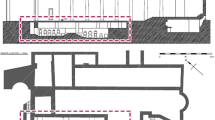Abstract
The Phrygian lived in the early seventh century BC and collapsed due to the attacks of nomadic Cimmerians in Anatolia. The Phrygia region which is also called Mountainous Phrygia covers the provinces of Eskisehir, Afyonkarahisar, and Kutahya in Turkey today. Three hundred forty-eight sites and 494 monuments are registered on the national inventory. These monuments are hosting many hundreds of years of knowledge about elder civilizations. The lion tombstone is one of the best protected monuments in Phrygia but it is in a possible danger of exploding by treasure hunters. The preservation of these monuments may not be always possible in physical but today’s technologies and methodologies allow us to preserve in digital environment by 3D models. The main advantage of digital documentation is conservation of the natural tissues and shapes of historical monument. This paper reports an application of 3D model generation of the lion tombstone from ancient Phrygia by using photogrammetric techniques.



Similar content being viewed by others
References
AgiSoft (2016), PhotoScan website http://www.agisoft.ru accessed 05 January 2016
Brilli M, Giustini F, Conte AM, Mercadal PL, Quarta G, Plumed HR, Scardozzi G, Belardi G (2015) Petrography, geochemistry, and cathodoluminescence of ancient white marble from quarries in the southern Phrygia and northern Caria regions of Turkey: considerations on provenance discrimination. J Archaeol Sci Rep 4:124–142
Böhler W, Heinz G, (1999) Documentation, surveying, photogrammetry. XVII CIPA Symposium, Olinda
Chiabrando F, Spanò A (2009) Digital wide scale orthoprojections and mapping from low-height aerial images. J Cult Herit 10S:e49–e58
Di Giacomo G, Ditaranto I, Scardozzi G (2011) Cartography of the archaeological surveys taken from an Ikonos stereo-pair: a case study of the territory of Hierapolis in Phrygia (Turkey). J Archaeol Sci 38:2051–2060
Eisenbeiss H (2009) UAV photogrammetry. Dissertation, Institute of Geodesy and Photogrammetry, Switzerland
Georgopoulos A, Ioannidis G, (2004) Photogrammetric and surveying methods for the geometric recording of archaeological monuments. Archaeological Surveys, FIG Working Week, Greece
Gomes L, Pereira Bellon OR, Silva L (2014) 3D reconstruction methods for digital preservation of cultural heritage: a survey. Pattern Recogn Lett 50:3–14
Kealhofer L, Grave P, Bahar H, Marsh B (2015) Between the states: Iron Age interaction in southwestern Anatolia. J Archaeol Sci Rep 3:342–357
Kulur S, Yilmazturk F, (2005) 3D reconstruction of small historical objects to exhibit in virtual museum by means of digital photogrammetry. CIPA XX International Symposium Italy
Pavlidis G, Koutsoudis A, Arnaoutoglou F, Tsioukas V, Chamzas C (2007) Methods for 3D digitization of cultural heritage. J Cult Herit 8:93–98
Remondino F, El-Hakim SF (2006) Image-based 3D modeling: a review. Photogrammetric Rec J 21:269–291
Scherer M (2001) About the synthesis of different methods in surveying. XVIII International Symposium of CIPA, Germany
Siebert S, Teizer J (2014) Mobile 3D mapping for surveying earthwork projects using an Unmanned Aerial Vehicle (UAV) system. Autom Constr 41:1–14
UNESCO (2016a) http://whc.unesco.org/en/tentativelists/6040/ Accessed 20 May 2016
UNESCO (2016b) http://whc.unesco.org/en/list/stat#s7 Accessed 20 May 2016
Funding
This study is supported by Afyon Kocatepe University, project numbered 13.FEN.BIL.11.
Author information
Authors and Affiliations
Corresponding author
Electronic supplementary material
ESM 1
(PDF 19937 kb)
Rights and permissions
About this article
Cite this article
Toprak, A.S., Polat, N. & Uysal, M. 3D modeling of lion tombstones with UAV photogrammetry: a case study in ancient Phrygia (Turkey). Archaeol Anthropol Sci 11, 1973–1976 (2019). https://doi.org/10.1007/s12520-018-0649-z
Received:
Accepted:
Published:
Issue Date:
DOI: https://doi.org/10.1007/s12520-018-0649-z




